The Mysterious Bent Pyramid
In former years the Diggings tour used to set out from Cairo and head across the desert by the shortest route to the Faiyum, usually stopping along the way at the Qom `aushim Museum, a neat little collection of antiquities with a most enthusiastic curator whom it was a pleasure to meet.
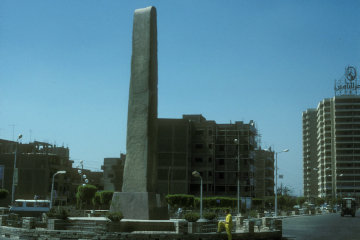
| |
| The repaired obelisk of Sesostris I stands in the middle of Faiyum. |
Then came a brief stop in the city of Faiyum itself to admire the Islamic wooden water wheels still groaning as they turned, and photograph the round-headed obelisk of Senusret (or Sesostris) I. Some maintain that it is not actually an obelisk but a very thin and elongated stela, a dispute I will leave to others to settle. What most tourists don't realise is that the obelisk/stela originally stood in the village of Abgig about a mile and a half to the south-west. It fell over and was broken into several pieces at some point in the past, but was repaired and brought to its present location in 1971.
From Faiyum we turned south-east and roughly followed the course of the Bahr Yusuf, the canal which links the Nile to the Faiyum. That took us first to Hawwara and its mud-brick pyramid built by Amenemhat III. In front of the pyramid is an extensive area of bare earth scattered with rock fragments. This is believed to be the site of the famous "Labyrinth" described by Herodotus, but which was so thoroughly robbed of its stone that Petrie wasn't even able to recover the ground plan!
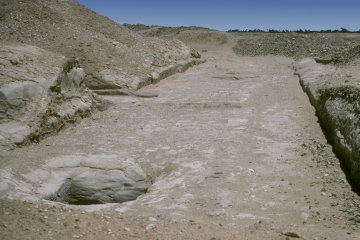
| |
| Two of the shafts leading to subsidiary tombs behind the pyramid of Lahun. |
Next on the tour was the Lahun pyramid, also of mud-brick and badly ruined. On one side there are a series of shafts leading down to tombs, probably for courtiers, about which I learned an amusing tale. At the conclusion of one of my lectures an elderly gentleman came to me and said that he had vivid memories of those shafts.
As a conscript stationed in Egypt after the Second World War he had taken advantage of a day off to go with a comrade, who shared his interest in history, to explore the pyramid of Kahun. Curious about the shafts, he dropped down into one of them to investigate but found only a small, empty chamber half-filled with wind-blown sand. Curiosity satisfied he attempted to climb out, only to discover that the shaft was just slightly too wide for him to brace his back against one side and his feet against the other, as he had intended. All his attempts failed and he was morosely contemplating adding to the pyramid's tally of dessicated inhabitants when his friend came past, looking for him. Belt, webbing and even trousers had to be knotted together to make a rope long enough to reach him and haul him out!

| |
| These heaps of rubble are all that is visible of the ancient village of Kahun. |
About half a mile from the pyramid is the site of the village of Kahun, constructed to house the workmen who built the pyramid. Sir Flinders Petrie, who excavated the village, drew up a plan which shows that it was divided into two unequal halves. The larger part contained large villas and stood on a slight eminence to catch whatever breezes might be passing. The smaller part was crammed with tiny two-room dwellings that in Britain we call "terraced" - that is, the side walls of one house formed the side walls of the adjacent houses. The two parts were separated by a strong wall, indicating that the inhabitants of the villas were nervous about contact with those in the terraces.
Curiously, the village appears to have been suddenly deserted, for countless objects of everyday use were found in the ruins - cooking utensils, craftsmen's tools, children's toys, even costume jewellery and make-up boxes. Dr Rosalie David, who wrote a book about the place, confesses herself baffled by this sudden departure, but I believe that Josephus holds a clue.
Having forgotten the benefits they had received from Joseph, particularly the crown being now come into another family, the Egyptians became very abusive to the Israelites and contrived many ways of afflicting them. They enjoined them to cut a great number of channels for the river and to build walls for their cities and ramparts that they might restrain the river. They set them also to build pyramids.
Josephus, Antiquities of the Jews, II.ix.1
Not only are the great pyramids long before any conceivable time for the Israelite captivity in Egypt, but the Bible describes the Jews as making mud bricks - and the pyramids of Gizeh and elsewhere are made of stone. However here you have an oppressed, if not enslaved, population building a mud-brick pyramid and then disappearing, leaving their possessions behind.

| |
| Stone and faiance jewellery abandoned by the departing Israelites. |
The Bible also tells us that before leaving, the Israelite women were to "ask her neighbour and any woman living in her house for articles of silver and gold and for clothing, which you will put on your sons and daughters. And so you will plunder the Egyptians." Exodus 3:22 (The KJV rather euphemistically refers to this "asking" as "borrowing"!) Why would any sane women cumber herself with pretty stone costume jewellery when she could be wearing gold, silver and precious stones? And likewise, why would the men lumber themselves with the tools of their slavery? If they never built another pyramid in their lives, they would be delighted!
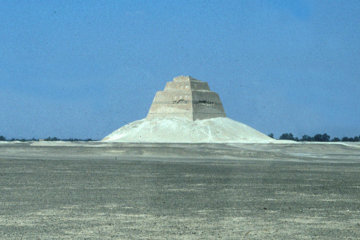
| |
| The pyramid of Meidum and the mound of fallen masonry that surrounds it. |
Our final stop of the day was at the point where the Bahr Yusuf joins the Nile Valley. The pyramid of Meidum is, probably, the most unusual of all Egypt's pyramids, mainly because it looks nothing like a pyramid! It is a squat stone tower standing on a large, artificial mound, and usually people express disappointment. Nevertheless, it was once a grand pyramid with smoothly sloping sides and the story of how it came to its present appearance is a fascinating one.
The secret was discovered by Kurt Mendelssohn, a civil engineer rather than an archaeologist. He visited Egypt once and took a few photographs of the pyramid of Meidum, but thought nothing of it. A few years later, however, he saw pictures of the disaster at Aberfan in south Wales, when a mine tip collapsed onto the unfortunate village. Suddenly he realised that the mound beneath the pyramid had exactly the same characteristics - it was the result of a catastrophic collapse!
He proceeded to study all he could find about the pyramid and discovered that unlike the earlier Step Pyrmid, where the bedrock had been cut away to produce a sloping surface, which caused all the layers of masonry to slope inwards, the Meidum pyramid was built on sand and with horizontal courses of stonework. As, in addition, the individual stones were quite roughly cut, this introduced a horizontal component into the internal pressures and stresses of the pyramid.
As the workers, in happy ignorance - this was one of the very early pyramids after all - continued to pile stone upon stone there came the point where just one more stone proved to be the proverbial straw and the whole of the outer layers came crashing down. The pyramid of Meidum is marked by bands of rough stone and Mendelssohn showed that the roughness was caused by stones cascading down from above and damaging the masonry beneath them.
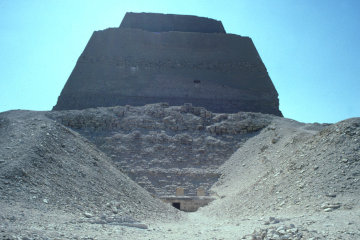
| |
| The mortuary temple of the Meidum pyramid still survives, but it is unfinished. |
This potentially solved a problem, for a bit of graffiti in the mortuary temple of the Meidum pyramid attributes the pyramid to Pharaoh Sneferu, the last pharaoh of the Third Dynasty. Nothing unusual in that, you might think, except that the nearby Bent Pyramid had numerous inscriptions stating that it, too, was built by Sneferu and there were indications that the Red Pyramid, just slightly further north, also belonged to Sneferu.
Pharaohs, of course, were not noted for their abstemiousness, but even so, three pyramids does seem a bit extravagant, even for a pharaoh. However if Sneferu's first pyramid had come crashing down to destruction, that provided a good reason for building a second!
But why the bend? Mendelssohn came up with two suggestions. The first is that pyramid building required a skilled workforce and it was possible that as soon as the bulk of one pyramid was completed, a significant proportion of this workforce was set to work on a second. This is possible, but I prefer his second suggestion, which is that the collapse of the Meidum pyramid caused a second to be started.
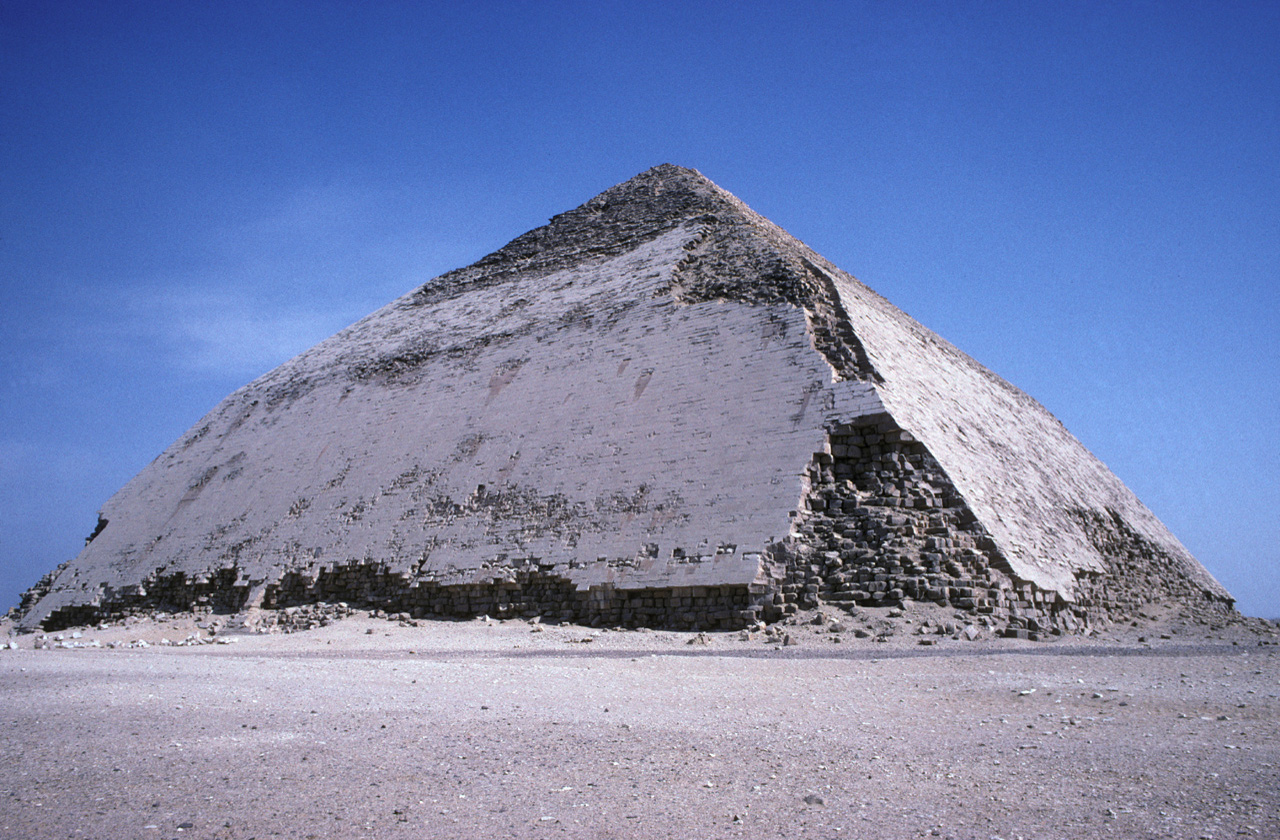
| |
| The Bent Pyramid is the only pyramid in Egypt to retain most of its outer casing stones. |
Unfortunately, although the architect had profited from the Meidum disaster and made sure that the Bent Pyramid was better built, when it reached a certain height cracks started to develop in the stonework. Fearing that this one would also go the way of its neighbour, they hastily changed the angle from 54° to 43° (without realising that as the bulk of the pyramid had already been completed, a lower angle in the upper part did not make much of a difference).
The only argument against this scenario is the fact that up to the bend the Bent Pyramid is built with inward-sloping courses of masonry, but after that the masonry is laid in horizontal courses. Personally I think the architect had just given up on the thing and wanted it finished as quickly and easily as possible.
However, Mendelssohn suggests, despite the pyramid being nearly finished, Sneferu was not happy at the prospect of his "House of Eternity" coming crashing about his mummified ears and therefore cancelled further work on the Bent Pyramid and instead commissioned a third pyramid, this one at the lower angle of 43° from the beginning.
We know that the Bent Pyramid was not finished because although the outer casing is complete and is the best preserved in Egypt, the burial chambers are only half-finished. Half of the corbelled roof of a chamber is nicely smoothed, the other half is still rough stone. On the other hand, the inner chambers of the Red Pyramid are beautifully finished throughout and its complete lack of facing stones on the exterior is due either to robbery (which is unlikely as there is no nearby big town to require the stone) or to Sneferu dying before it could be put in place.

| |
| The red arrow points to the western entrance to the Bent Pyrmid, which is higth on the north side. |
Notice that I said "chambers" when talking of the Bent Pyramid. The Bent Pyramid is unique in Egypt in that it has two separate entrances, one on the north side and a second, rather higher up, on the west side. The northern entrance leads by a 256' long passage to a burial chamber that is below ground level. The western entrance leads to an entirely separate burial chamber high up in the structure of the pyramid.
People have long puzzled over the question of why there are two entrances and two burial chambers, but I am sure that the answer is simply security. The northern entrance, though steep and low, which is an inconvenience for anyone trying to traverse it, is on the usual side for pyramid entrances and leads straight into the burial chamber.
The western entrance, on the other hand, is high up on the side of the pyramid and so small that it is hard to spot against the bulk of the pyramid. Furthermore anyone trying to use it encounters not one but two stone traps (often referred to as "portcullises") which were supposed to block the passageway. They consist of huge stone blocks set on a bed that slopes at 45°. Originally they were held open with baulks of timber and the intention was that when the timber was removed, the blocks would slide down into place, sealing the passageway beyond.
Curiously, the first of these traps is still held up by an ancient piece of timber - which I must admit would cause me to walk very delicately! 4,600 year old timber is probably not in the best of condition, no matter how dry the air is in Egypt. The second did slide down into place - and thereby hangs another puzzle.
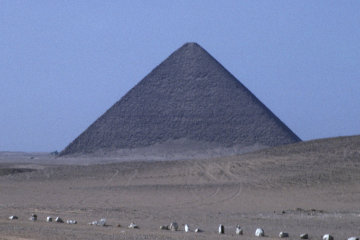
| |
| The Red Pyramid is built entirely at the lower angle of the top of the Bent Pyramid. |
The two entrances and the two entrance ways are entirely separate, but at some point in antiquity someone with a good sense of direction climbed up the side of the northern burial chamber almost to the top and hacked a rough passage from the chamber through to the passageway from the western entrance. The fact that this rough passage starts 50' above the floor of the chamber probably indicates that it was not intended to be seen, for it would be lost in the gloom, beyond the reach of lamp- or candle-light.
This rough passage joins the western entrance-way in between the two portcullises. As the second had been allowed to block the passage, the same persons unknown hacked a hole through the blocking stone to give them access to the burial chamber beyond. They would not have gone to all that trouble if there was nothing worth accessing inside the chamber! It seems highly likely, therefore, that the rough tunnel was the work of tomb robbers, who must have been aware of the location of the other burial chamber - which in turn argues that the tomb robbers and the tomb builders were probably the same people!
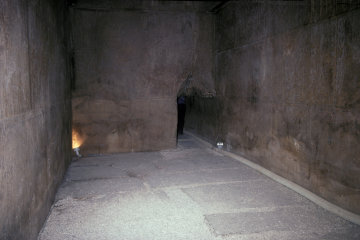
| |
| The first hidden doorway in the Red Pyramid, intended to confuse tomb robbers. |
Security was obviously on Sneferu's mind, because the Red Pyramid also incorporates features intended to frustrate tomb robbers. At the bottom of a long, sloping shaft you come to a large room, finely finished. At the far end of the room, but offset to the right, there is a doorway that, I suspect, was originally blocked with a piece of stone which looked just like the rest of the walls.
Through the doorway you come into another large chamber, also finely finished. High up in the further wall there is a small doorway. Today there is a substantial wooden staircase the spirals up to the door, but originally it would have been invisible in the darkness and you would have needed a long ladder to reach it. Beyond the doorway there is a short passage and then a much smaller room that was probably the final burial chamber. It is difficult to be sure, because someone has dug up the floor, leaving a hole ten feet deep where the floor should be. Possibly the robbers suspected the presence of another chamber stuffed with treasure, but as far as we can tell they must have been disappointed.
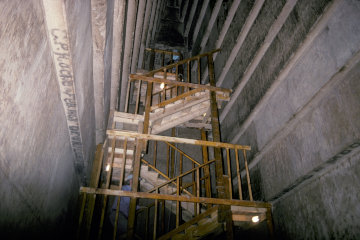
| |
| The upper half of the modern stairway to the second hidden doorway in the Red Pyramid |
Actually, they would have had better reason for suspecting hidden chambers in the Bent Pyramid. When J.S. Perring dug his way through wind-drifted sand and rubble to open the northern entrance into the pyramid, his lights were extingished by a strong draught that blew into the pyramid - and continued blowing for two whole days! To this day there has been no explanation for this phenomenon. Because the western entrance was still blocked, some suspected a hidden chamber which had developed a near vacuum over the millennia, but not only is that unlikely - it would have to be a positively vast chamber to cause a draught that lasted two days - but recent x-rays of the pyramid have failed to reveal any chambers apart from the ones we already know about.
For half a century the Bent Pyramid has been closed to visitors. First no one was allowed near it because it was - allegedly - in a sensitive military area. (This mirrors the excuse given after the 1967 Six-day War for stopping tourists climbing the Great Pyramid: they might look down on nearby military camps and even take photographs of them! Clearly the Egyptians had never heard of spy satellites.) We would often drive past it, looking longingly at the Bent and Red pyramids. Then, about twenty years ago, the military died or migrated or ceased to be a believable excuse and tourists were allowed to drive up to both pyramids and walk round them. The following year the Red Pyramid was opened to visitors, but up until now the Bent Pyramid has remained closed.
Now, with Egypt facing parlous times due to the lack of visitors, the government has opened the Bent Pyramid in the hope of luring tourists back. I hope they are successful - I would certainly wish to see the interior of the Bent Pyramid - but I won't go back until the policy instituted by Zahi Hawass, which forbade any photography inside any of the monuments in Egypt, is reversed.
Watch this space.
© Kendall K. Down 2019





